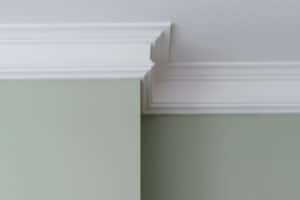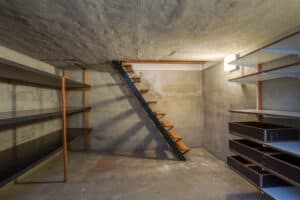
One of the most important parts of building a new home is installing the plumbing.
You may have a few special requests or ideas for your bathroom or kitchen.
Those ideas may come with a hefty price tag, but you may also wonder how much it costs to plumb a home on average.
In this article, we break down the cost to plumb a new house and dig deep into the expenses.
What Is The Cost To Plumb A New House?

The average cost to plumb a new house is $7,500.
The lowest estimate to plumb a new house is $1,500.
However, certain circumstances can drive your cost as high as $15,000.
We can break this amount down further by examining the cost to plumb a 2,300-square-foot home with 2.5 bathrooms.
That kind of project averages out to be $11,500.
As a rule of thumb, you should plan to spend $4.50 per square foot on your plumbing costs.
Factors That Influence The Price To Plumb A New House

There are a few factors that inflate or reduce the price to plumb a new house.
They include:
- The location of the pipes
- Number of bathrooms
- Plumbing materials
- Plumber’s hourly wage (if applicable)
Let’s dig into these further.
1. Location Of The Pipes

If it’s more difficult to connect your bathroom to the sewer or septic tank, then you can expect a higher price.
It requires the plumber to do more work and spend more time on your house.
They may even need to bring in special tools to access parts of your home to lay in the plumbing.
The location also determines how many materials the plumber will need to plumb the house.
The more pipes that a house needs to connect it to the main sewer line, for example, the higher the price for the job.
To reduce the cost of your plumbing installation, you should make the bathrooms accessible.
Place them on the edges of the house rather than in the interior.
If possible, try to place the bathrooms closest to the sewer line or septic tank to reduce the number of pipes you’ll need.
2. Number Of Bathrooms

If your home has a lot of bathrooms, then you can expect the price of plumbing installation to be high.
Every plumber will give you a quote based on the number of fixtures in each room.
Every fixture means a pipe is going to need to be installed.
A home that only has one or two bathrooms and a kitchen will be significantly cheaper to plumb than a home that has four or five bathrooms and a kitchen.
Those two rooms aren’t exclusive either.
You may need a plumber to install plumbing for a hot tub or an outdoor kitchen area.
The more fixtures you have in the home, based on the number of bathrooms, the costlier the project.
You can reduce the cost to plumb a new house by limiting yourself to a small number of bathrooms.
Instead of a bathroom in every corner, you may want to settle for a bathroom on every floor.
3. Plumbing Materials

The type of plumbing material you choose to use for your pipes can also impact the price.
The most expensive type of pipe material is copper.
The least expensive type of pipe material is either PVC or a new material known as PEX.
If your home requires a lot of piping, then the cost can increase based on the material used.
Using a lot more copper pipes is going to be far more expensive than using a lot of PVC or PEX pipes.
If you want to reduce the cost of your plumbing, then you may want to choose either PVC or PEX for your piping.
4. Plumber’s Hourly Wage

The final factor that influences the price to plumb a new house is the plumber’s pay rate.
Some plumbers charge by the hour.
If you have a big project, then a plumber who charges by the hour is going to be more expensive than one who charges a flat rate.
On the other side of the spectrum, if you have a small job, then a plumber who charges by the hour may be a cheaper option than one who charges a flat rate.
Consider both options when choosing a plumber to plumb the new house.
You’ll also want them to estimate the length of the project.
You can then compare the hourly price to the flat rate based on the number of hours they expect the job will take.
What Is The Cost To Plumb A New House With PEX Piping?

PEX costs 50 cents to $2 per square foot to install.
For a 2,500 square-foot home, this will average out to $1,250 for 50 cents on a single bathroom.
Double that amount if you want to install a second bathroom.
For a 2,500 square-foot home based on the $2 estimate, the average increases to $5,000 on a single bathroom.
Considering that PEX is one of the cheaper options, you can imagine how pricey using copper can become.
The major price difference between PEX and copper piping is labor.
With PEX piping, the cost associated with it stems from the hourly wage or flat rate that the plumber charges.
It doesn’t stem from the piping itself because that’s relatively cheap.
PEX is a relatively new material that many plumbers are adopting when they plumb a new house.
It has a few advantages over copper piping, but there are disadvantages, too.
The Benefits Of Using PEX Piping

One of the best aspects of PEX piping is that it doesn’t freeze.
This is a flaw with copper pipes.
When temperatures drop, the water in copper pipes can start to freeze and become solid.
As a solid, water can form clogs when solids try to pass through the pipe.
The result is a burst pipe from the pressure.
PEX doesn’t have that problem.
It’s a kind of tubing rather than a stiff metal.
Its material prevents it from freezing.
As a result, it doesn’t burst or develop leaks caused by freezing.
Another benefit of PEX is that it’s resistant to corrosion.
Its material isn’t metallic.
This is beneficial over piping materials like steel or iron.
Over time, water can start to make those materials rust.
The pipes will degrade and leak.
It also leaks rust into your water.
PEX doesn’t corrode.
You don’t have to worry about rust eating away at your pipe or having it enter your drinking water.
The third benefit of PEX piping is that it’s cheap and easy to install.
The tubing is made of flexible plastic.
It allows the plumber to snake it through the walls without any problems.
It can even curve around corners without needing to open up walls to pull it through.
Since it’s so easy to use, it takes less time to install it.
That, alone, can make your plumbing installation a lot cheaper.
As a side benefit of this feature, it also means the plumber will need to drill fewer holes in the wall.
If you ever need to replace your plumbing in the future, then using PEX will ensure that as little damage as possible happens to your walls.
A cool feature of PEX is that it can connect to a PEX manifold.
This is like a circuit breaker for your plumbing.
Each tube connects to a fixture on the manifold.
The manifold allows you to turn off the water that’s going to a specific fixture.
If you need a plumber to fix a specific fixture, then you don’t need to turn off the water to the entire home.
You can turn off only the specific feature instead.
A final benefit of PEX piping is that it retains heat.
You may spend some time at your sink waiting for the water to heat up to use.
PEX piping decreases the amount of time that you wait.
Since it heats up faster, your water heater will need to work less.
That can save you on water costs, water usage, and help extend the life of your water heater.
What Are The Disadvantages Of Using PEX Piping?

Although there are many advantages of using PEX piping to bring down the cost to plumb a new house, there are some disadvantages, too.
One of the concerns stems from its newness.
Because it hasn’t been on the market or in use for very long, experts don’t know about its long-term effects on health and safety.
Nor are they sure about how long it can last, the kind of deterioration it sees, and any other complications it may undergo as it ages.
If you choose to use PEX in your home, then you’re becoming part of the experiment.
You’ll be among those testing PEX to see how it performs over the years.
Another problem is that the tubes are susceptible to rodents.
With copper piping, the metal is too strong to break or receive damage from chewing rodents.
That isn’t the case with PEX.
It uses a soft tubing material that rodents can easily chew through.
If you often have mice or other rodents getting into your home, then this may be a serious problem for you.
They can access the interior of your wall and chew on the PEX tubing.
Their puncture marks may cause holes and create leaks throughout the tubing.
If you use PEX, then you need to make sure that your home is rodent-proof.
A third disadvantage is that it becomes damaged by chlorine.
The chemicals used to manufacture the tubing can start to lose their cohesion when they’re exposed to chlorine.
That means dumping certain detergents and cleaners down the drain isn’t a good idea.
It can have a serious impact on the longevity of your PEX piping.
A problem that some PEX tubing encounters is its reaction to the sun.
If PEX receives exposure to the sun before it’s installed, it can deteriorate.
This is part of the nature of the materials that make up the tubing.
This phenomenon requires plumbers to keep it hidden when they’re transporting it into your home.
This isn’t a serious problem for experienced plumbers, but if a plumber has an off day or they’re inexperienced with PEX, then it could affect how well your plumbing installation goes.
One final problem with PEX tubing is that it’s permeable.
This is a problem if PEX runs underground and comes into contact with groundwater.
Anything can get into your groundwater.
Runoff from factories, from washing your car, from nearby farms, and even gas or oil spills can cause contaminants to enter your groundwater.
Since PEX is permeable, it can soak up those pollutants and allow them to enter your drinking water.
You may end up drinking gasoline or other harsh chemicals if you don’t use a filter.
What Is The Cost To Plumb A New House With Copper Piping?

Copper piping costs $2 to $5 per square foot.
For a 2,500-square-foot home with one bathroom, that’s $5,000 to start.
Using the same example, that’s $12,500 for the $5 price point.
Clearly, using copper piping is more expensive than PEX.
However, copper has a few benefits that PEX doesn’t offer.
Those benefits and features may make the extra cost of copper worth it.
The Benefits Of Using Copper Piping

One of the main reasons homeowners choose copper over other materials is its history.
Copper replaced steel pipes several decades ago.
Thanks to its long history, experts know that it’s safe to use and transport potable water to the home.
It has incredible durability, too.
It can last anywhere from 50 to 70 years.
While the expense to install copper pipes is significant, you also be sure that you don’t need to replace them again for several decades.
You may not need to replace them at all if you end up selling the home within that time.
They’re also built to last.
Since copper is a metal, it can hold up well against damage.
You can still poke holes through it, but there’s less of a chance of it tearing since it isn’t a soft plastic.
Another advantage is that it doesn’t leach.
Some materials can leach chemicals through it and allow it to enter your drinking water.
The only thing passing through your copper pipe is the water, itself.
If it’s contaminated, then you know it’s from the source of water and not the pipes.
Copper pipes are also lightweight and easy to carry.
They’re not as flexible as PEX tubing and need a bit more finesse to install them, but they’re easy to maneuver.
Plumbers can carry several pipes into the home in a single transport and not have to worry about sun exposure.
One final benefit of copper pipes is that they’re fire-resistant.
If an electrical fire starts in your home, then it won’t impact your plumbing.
What Are The Disadvantages Of Using Copper Piping?

While copper pipes have several strengths, there are a few disadvantages that may influence your decision to spend the extra money on them or not.
The main disadvantage is the price point.
Copper is expensive and always will be expensive.
Since copper is expensive on its own, you’re going to need to factor in the cost of labor, too.
That can make the price for a plumbing project on a new house skyrocket.
Another problem is that copper pipes can freeze.
They’re susceptible to the cold and hold it well.
When the water inside of the pipe freezes, it becomes solid.
This can cause clogs and pressure build-ups which can make the copper pipe burst.
These repairs can be pricey, especially if you need to deal with water damage as well.
Certain acids can also degrade the pipe prematurely.
They don’t interact well with acidic water.
A chemical like formaldehyde can degrade the pipe.
If your groundwater has a lot of acidic elements in it, then it could age your pipes faster.
This leads to the other problem with copper pipes: leaks are difficult to detect.
When a copper pipe leaks, it’s usually slow.
You may not notice the damage until it has become significant.
Repairing leaky copper pipes can be expensive.
One final disadvantage of copper pipes is their ability to start fires.
While copper pipes are fire-resistant, they can start fires.
When the pipe grows hot, it can scald any wooden beams that it’s touching.
If the heat persists, then the wood can catch fire and spread.
You may not even realize where the fire is before it’s too late to stop it.
Copper has a lot of advantages over PEX tubing, but its disadvantages, along with its expense, may make it too costly for homeowners.
Conclusion

If you want to make plumbing a new house as cheap as possible, then you want to limit the number of bathrooms you have and consider using PEX tubing as your plumbing material.
If you have a larger budget, then you may want to consider using copper pipes for their trusted performance and long lifespan.
Consider the examples and factors above to estimate the specific plumbing costs of your new house.




How much should I charge for final trim 2 1/2 bathrooms
nice article like it !